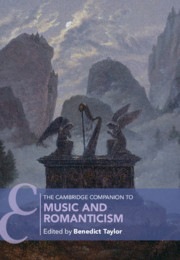Book contents
- The Cambridge Companion to Music and Romanticism
- Cambridge Companions to Music
- The Cambridge Companion to Music and Romanticism
- Copyright page
- Contents
- Figures
- Tables
- Musical Examples
- Contributors
- Preface
- Chronology
- Part I Horizons
- 1 Defining the Indefinable: Romanticism and Music
- 2 The Emergence of Musical Romanticism
- Part II Worlds
- Part III Aesthetics
- Part IV Practices
- Part V Histories
- Select Bibliography
- Index
- References
1 - Defining the Indefinable: Romanticism and Music
from Part I - Horizons
Published online by Cambridge University Press: 06 August 2021
- The Cambridge Companion to Music and Romanticism
- Cambridge Companions to Music
- The Cambridge Companion to Music and Romanticism
- Copyright page
- Contents
- Figures
- Tables
- Musical Examples
- Contributors
- Preface
- Chronology
- Part I Horizons
- 1 Defining the Indefinable: Romanticism and Music
- 2 The Emergence of Musical Romanticism
- Part II Worlds
- Part III Aesthetics
- Part IV Practices
- Part V Histories
- Select Bibliography
- Index
- References
Summary
This chapter provides an accessible starting point for discussion of the relation between music and Romanticism, giving an overview of some of the issues frequently encountered in coming to an understanding of how the two intersect.It outlines some of the main debates about the nature of Romanticism, before turning attention specifically to the idea’s application to music. Three main positions are set out: Romanticism as a period in music history, Romanticism as a musical style, and Romanticism as an aesthetic or mode of understanding.Although these three definitions are not without their problems, each relates to an important aspect of how Romanticism may relate to music, and while the third is probably to be preferred, the first two also demand consideration in any account of this topic.
Keywords
- Type
- Chapter
- Information
- The Cambridge Companion to Music and Romanticism , pp. 3 - 16Publisher: Cambridge University PressPrint publication year: 2021
References
Further Reading
- 1
- Cited by

